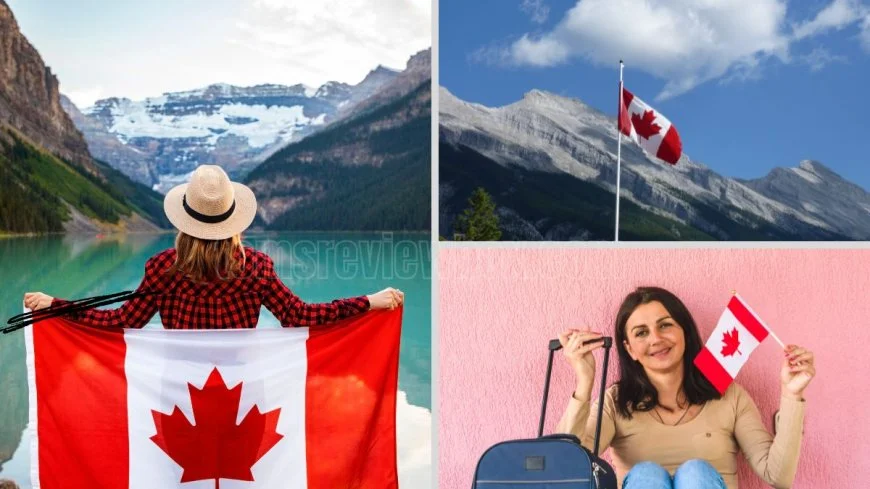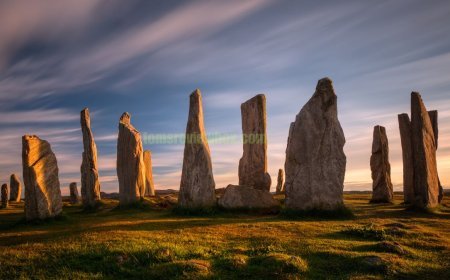When is the Best Time to Travel to Canada? Seasonal Highlights!
Discover the best time to travel to Canada with seasonal highlights and activities. Plan your trip with our expert insights!

When is the best time to travel to Canada? The answer varies depending on your interests. Winter offers stunning snowy landscapes and thrilling activities like skiing, snowboarding, dog sledding, and outdoor recreation during the holiday season and season hiking. However, summer brings vibrant festivals, lush parks, rugged landscapes, and warm weather perfect for hiking in the north. Each season has its charm, making Canada a year-round destination on land.
Spring showcases blooming flowers and mild temperatures, while fall dazzles with colorful foliage. Planning your trip around these seasonal highlights can enhance your experience. Whether you're an adventure seeker or a culture lover, knowing when to visit will help you make the most of your Canadian journey. Discovering the right time to travel can transform your trip from ordinary to extraordinary.
Best Time to Visit Canada
Overview of Seasons
Canada experiences four distinct seasons. Each season brings its own charm.
Spring runs from March to May. The weather warms up, and flowers bloom. This season is perfect for seeing nature come alive.
Summer, from June to August, is warm and vibrant. Travelers enjoy outdoor activities like hiking and festivals. However, this season can be crowded with tourists.
Autumn, or fall, occurs from September to November. The leaves change color, creating stunning views. It’s a great time for photography and enjoying cooler temperatures.
Winter lasts from December to February. Snow covers the landscape, making it ideal for winter sports. Skiing and snowboarding attract many visitors during this time.
Seasonal changes greatly impact weather and activities. Spring offers mild temperatures, while summer heats up. Autumn brings cooler air, and winter often features freezing temperatures.
Popular Travel Months
April to June and September to November are considered the best travel months. Spring welcomes blooming flowers and comfortable weather. This makes it a lovely time for sightseeing.
Summer attracts many visitors due to outdoor adventures. Hiking, camping, and festivals fill the calendar. However, prices often rise during peak summer months.
September to November showcases beautiful fall foliage. Cooler temperatures make it pleasant for outdoor exploration. Winter also draws crowds for skiing and cultural events like Christmas markets.
Pros and Cons by Season
Traveling in summer has its perks. Festivals abound, offering unique experiences. Outdoor activities are plentiful, making it an exciting time to visit.
However, there are drawbacks to consider. High costs can strain budgets during peak season. Crowds at popular attractions can diminish enjoyment.
Winter has its own allure with snowy landscapes and festive spirit. Unique experiences await those who embrace the cold weather.
Yet challenges exist during winter travel. Cold temperatures may deter some visitors. Limited daylight hours can shorten sightseeing opportunities.
Why Choose Shoulder Seasons
Benefits of Shoulder Seasons
Traveling during shoulder seasons offers unique opportunities. Visitors can experience authentic local interactions. Fewer tourists mean locals have more time to engage with travelers. This creates a richer travel experience.
Pleasant weather is another advantage. Spring and fall often bring mild temperatures. These conditions allow for outdoor activities without the summer heat.
Accommodations and attractions are more accessible in shoulder seasons. Hotels offer better rates and availability. Many popular sites also have shorter lines, making it easier to explore.
Cost Savings
Traveling during shoulder seasons can lead to significant cost savings. Flights are often cheaper in off-peak months. Airlines reduce prices to fill seats when fewer people are traveling. This can result in substantial savings on airfare.
Accommodations also see price drops during these times. Hotels and rentals frequently offer discounts to attract guests. Travelers can find deals that are hard to come by in peak seasons.
Fewer tourists can lower attraction fees as well. Some sites offer reduced prices or special promotions when crowds are smaller. This means visitors can enjoy more while spending less.
Fewer Crowds
Shoulder seasons provide a chance to visit popular attractions with fewer crowds. Long wait times become a thing of the past. Visitors can enjoy their favorite sites without the hassle of large groups.
Exploring cities becomes more enjoyable with less congestion. Walking through streets or parks feels more peaceful. Nature lovers appreciate the tranquility of national parks during these times.
Fewer people enhance the overall experience. Travelers can take their time at museums or landmarks. This allows for deeper appreciation of the sights and sounds around them.
Winter Travel Highlights
Skiing and Snowboarding
December to March marks the prime winter months for skiing in the Rockies. This period offers consistent snowfall and excellent conditions. Popular ski resorts include Whistler Blackcomb, Banff, and Jasper. Each resort provides a unique experience. Skiers of all skill levels can find suitable slopes.
Snowboarding also attracts many visitors. Resorts often feature dedicated snowboarding parks with jumps and rails. Snowshoeing is another popular winter activity. It allows people to explore beautiful landscapes at a slower pace. The west climate enhances the appeal of these winter sports.
Northern Lights Viewing
The best months for viewing the Northern Lights in Canada are from late September to early April. During this time, nights are longer and darker, providing optimal conditions. Locations like Yellowknife, Whitehorse, and Nunavut offer stunning views of this natural spectacle.
These areas have minimal light pollution, which improves visibility. Witnessing the aurora borealis is a magical experience. The vibrant colors dancing across the sky create unforgettable memories. Many travelers plan their trips specifically to see this phenomenon.
Winter Festivals
Canada hosts numerous winter festivals that celebrate the season. Events like the Quebec Winter Carnival and Winterlude in Ottawa attract large crowds. These festivals showcase local culture through music, food, and art.
Activities range from ice sculptures to snow slides and parades. They bring together locals and tourists alike, fostering community spirit. Cultural significance lies in celebrating traditions during the cold months. Visitors enjoy unique experiences that highlight Canada's diverse heritage.
Spring Adventures
Wildlife Watching
Spring is a prime time for wildlife watching in Canada. Animals emerge from hibernation, making them more visible. Parks like Banff and Jasper offer unique opportunities to see bears, moose, and elk.
In April and May, black bears roam the valleys. Elk are often spotted in the meadows during this time too. Birdwatchers can enjoy the return of migratory birds in spring. The vibrant colors of these birds add beauty to the landscape.
National parks provide a natural habitat for many species. Visitors can join guided tours for a better chance of spotting wildlife. These tours often lead to unforgettable encounters with nature.
Cherry Blossoms in Vancouver
Cherry blossoms bloom in early April in Vancouver. This event transforms the city into a stunning display of pink flowers. The peak bloom lasts about two weeks, typically around mid-April.
Cultural events celebrate this beautiful season. The Vancouver Cherry Blossom Festival features music, dance, and art. These festivities attract locals and tourists alike.
Best locations for viewing include Queen Elizabeth Park and Stanley Park. Both parks provide breathtaking views of the blossoms. Visitors can take leisurely walks under the trees or have picnics on the grass.
National Parks Reopening
National parks usually reopen in late April or early May. Each park has its specific dates based on weather conditions. Planning visits around these dates is essential for enjoying the full range of activities.
Once parks open, numerous adventures await. Hiking trails become accessible, offering scenic views. Camping options also become available, allowing visitors to spend nights under the stars.
Activities like canoeing and fishing start as lakes thaw out. Wildlife sightings increase as animals become active again. It’s important to check park websites for updated information on reopening dates.
Summer Experiences
Outdoor Activities
Summer holidays in Canada bring many outdoor activities. Hiking and biking are popular during this season. The summer climates create ideal conditions for these adventures. National parks like Banff and Jasper offer stunning trails. Lakes and rivers provide perfect spots for kayaking and canoeing.
Winter, on the other hand, offers different experiences. Ice skating and snowmobiling become popular activities. Many Canadians embrace winter sports like skiing and snowboarding as well. Each season presents unique opportunities for fun.
Festivals and Events
Canada hosts numerous festivals throughout the year. Summer is filled with vibrant celebrations that reflect Canadian culture. Events like the Calgary Stampede in July showcase rodeo traditions. The Toronto International Film Festival in September highlights cinematic achievements.
These festivals vary by season. Winter events often focus on holiday themes, while summer events celebrate outdoor life. Festivals can include music, food, and art, attracting everyone. They also allow visitors to experience local heritage firsthand.
Road Trips
Road trips are a great way to explore Canada’s diverse landscapes. Summer is an ideal time for long drives along the coast or through the mountains. Routes like the Icefields Parkway offer breathtaking views in warmer months.
Shoulder seasons, such as late spring or early fall, provide fewer crowds. This makes travel more enjoyable. Scenic routes like Cabot Trail reveal stunning coastal vistas during these times. Travelers can appreciate nature without the hustle of peak tourist seasons.
Fall Activities
Fall Foliage Tours
Stunning fall colors light up Canada in September and October. During this time, vibrant reds, oranges, and yellows cover the trees. The best viewing times vary by region but generally peak in late September to mid-October. Areas like Quebec's Laurentians and Ontario's Algonquin Park are known for breathtaking autumn scenery.
Visitors can enjoy activities such as scenic drives, guided tours, and photography sessions. Many parks offer walking trails to experience the beauty up close. Local businesses often provide special packages for foliage tours, making it easy to explore.
Harvest Festivals
Canada celebrates several key harvest festivals during the fall. One of the largest is the Canadian Thanksgiving, celebrated on the second Monday in October. This holiday features local produce like pumpkins, apples, and corn.
Festivals such as the Kitchener-Waterloo Oktoberfest showcase German culture with food and music. Community involvement is strong at these events. Families gather to enjoy traditional foods and participate in activities. These festivals highlight local traditions and foster a sense of belonging.
Hiking Trails
Fall is an excellent time to hike in Canada. The cooler weather makes hiking more comfortable compared to summer heat. Popular regions for hiking include the Rocky Mountains and Cape Breton Highlands National Park.
Trails like the West Coast Trail become accessible after summer crowds leave. However, hikers should be prepared for changing weather conditions. Dressing in layers helps manage temperature changes during hikes. Always check trail conditions before heading out.
Safety tips include carrying enough water and snacks. It's also wise to inform someone about your hiking plans.
Best Travel Time by Destination
Rocky Mountains
The Rocky Mountains offer unique seasonal experiences. In summer, visitors enjoy hiking and camping. Trails open up, revealing stunning landscapes. Wildlife sightings are common during warmer months. Many people also go fishing in the lakes.
Winter transforms the Rockies into a snow-covered paradise. Skiing and snowboarding attract thrill-seekers. Snowshoeing and ice skating provide fun alternatives. The breathtaking views remain constant throughout the year. Each season showcases the mountains in different lights and colors.
British Columbia
The best months to visit British Columbia are from May to September. During this period, the weather is warm and pleasant. Travelers can explore national parks or relax on beautiful beaches. Summer festivals add excitement to the atmosphere.
In winter, British Columbia offers skiing and snow sports in the mountains. Whistler is a popular destination for these activities. Spring brings blooming flowers and wildlife watching opportunities. Fall showcases vibrant foliage across the province, making it an excellent time for photography.
The region's unique climate greatly impacts travel experiences. Coastal areas tend to be milder than inland regions. Rain is more common in fall and winter, so packing accordingly is essential.
Eastern Canada
Traveling in Eastern Canada reveals seasonal highlights that vary greatly. Summer brings lively festivals and outdoor events. Cities like Montreal host jazz festivals that attract many visitors.
Fall is famous for its stunning foliage, especially in Quebec and Ontario. Tourists flock to see colorful leaves change before winter arrives. Winter features traditional activities like ice skating on frozen lakes.
Spring marks a time of renewal with cultural events celebrating local traditions. The best times to visit depend on what travelers want to experience. Festivals often occur in summer and early fall, showcasing local culture.
Top Activities Year-Round
National Parks
Canada's national parks offer stunning landscapes. Seasonal accessibility varies significantly. Summer is popular for hiking and camping. Parks like Banff and Jasper see many visitors during this time. Winter transforms these parks into winter wonderlands. Skiing and snowshoeing become the main activities.
Each season provides unique experiences. Spring brings blooming wildflowers, while fall showcases vibrant foliage. Planning ahead is crucial for popular parks. Reservations may be needed for accommodations and activities, especially in peak seasons.
Wildlife Encounters
Wildlife encounters are a major draw in Canada. Certain times of the year are best for spotting wildlife. For example, spring is ideal for seeing bears emerge from hibernation. Locations like Yellowstone National Park offer great viewing opportunities.
Summer months attract various species, including moose and deer. Fall is perfect for observing migratory birds as they pass through. Responsible wildlife observation is essential. Keep a safe distance and avoid feeding animals to protect their natural behavior.
Cultural Experiences
Cultural experiences highlight Canada's rich heritage. Seasonal festivals showcase local traditions and customs. Winter festivals often feature ice sculptures and snow sports. Events like the Quebec Winter Carnival attract thousands each year.
During summer, music festivals celebrate Canadian artists and cultures. Engaging with local communities enriches travel experiences. Visitors learn about indigenous cultures through art, dance, and storytelling events.
Plan Your Canadian Getaway
Booking Tips
Travelers should consider the peak and shoulder seasons when booking trips to Canada. Peak seasons, like summer, draw large crowds. Prices for flights and hotels can rise significantly during these times. Booking in advance can secure better rates and availability. Early bookings help travelers avoid last-minute price hikes.
Shoulder seasons, such as late spring or early fall, often offer lower prices. These times also provide a chance to experience fewer tourists. Flexibility with travel dates can lead to great deals. Adjusting plans by just a few days may save money on flights and accommodations.
Packing Essentials
Packing varies based on the season in Canada. Winter travelers need heavy coats, gloves, and boots. Summer visitors should prepare for warm weather with light clothing and sunscreen.
Layering is key in Canada’s unpredictable climate. Mornings can be chilly while afternoons may heat up. A mix of short-sleeved shirts, long sleeves, and light jackets works well year-round. For winter sports, items like thermal wear and snow pants are essential for skiing or snowboarding.
Local Insights
Travelers should seek local advice for the best experiences in Canada. Residents often know the best parks, restaurants, and events that aren’t in guidebooks. Connecting with locals can reveal hidden gems off the beaten path.
Respecting local customs is also important. Each province has unique traditions and practices. Understanding these helps foster positive interactions with residents. Engaging with communities adds depth to any trip.
Remarks Finales
Traveling to Canada is all about timing. Each season offers unique experiences. Whether you’re hitting the slopes in winter or soaking up the sun in summer, there’s something for everyone. Shoulder seasons are perfect for avoiding crowds while still enjoying mild weather.
Plan your trip based on your interests and destination. Dive into seasonal activities that showcase Canada’s beauty. Don’t miss out on the adventures waiting for you. Start mapping out your Canadian getaway today. Your next unforgettable experience is just around the corner!
Frequently Asked Questions
When is the best time to visit Canada?
The best time to visit Canada is during the shoulder seasons: late spring (May to June) and early fall (September to October). These months offer mild weather, fewer crowds, and vibrant natural beauty.
What are the advantages of traveling in shoulder seasons?
Shoulder seasons provide lower prices, fewer tourists, and a chance to experience local culture. You can enjoy popular attractions without long lines and take advantage of special events and festivals.
Is winter a good time to travel to Canada?
Yes! Winter offers unique experiences like skiing, snowboarding, and ice festivals. Popular destinations like Whistler and Quebec City come alive with winter activities and stunning snowy landscapes.
What outdoor activities can I do in spring?
Spring is perfect for hiking, biking, and wildlife watching as nature awakens. Enjoy blooming flowers in national parks and participate in local festivals celebrating the season.
What summer activities should I not miss in Canada?
Summer is ideal for outdoor adventures such as camping, kayaking, and attending music festivals. Explore Canada’s beautiful lakes and national parks during this vibrant season.
What makes fall a great time to visit Canada?
Fall showcases breathtaking foliage, especially in regions like Ontario and Quebec. It’s also harvest season, offering unique culinary experiences through food festivals and apple picking.
How can I plan my Canadian getaway effectively?
Research your destination’s climate and activities beforehand. Consider booking accommodations early during peak seasons and check local event calendars for any special happenings during your visit.
What's Your Reaction?







































![MacBook Pro M5: All the features and specs you need to know [LEAKS REVEALED]](https://tomsreviewbox.com/uploads/images/202502/image_430x256_67bd6d7cd7562.jpg)



























